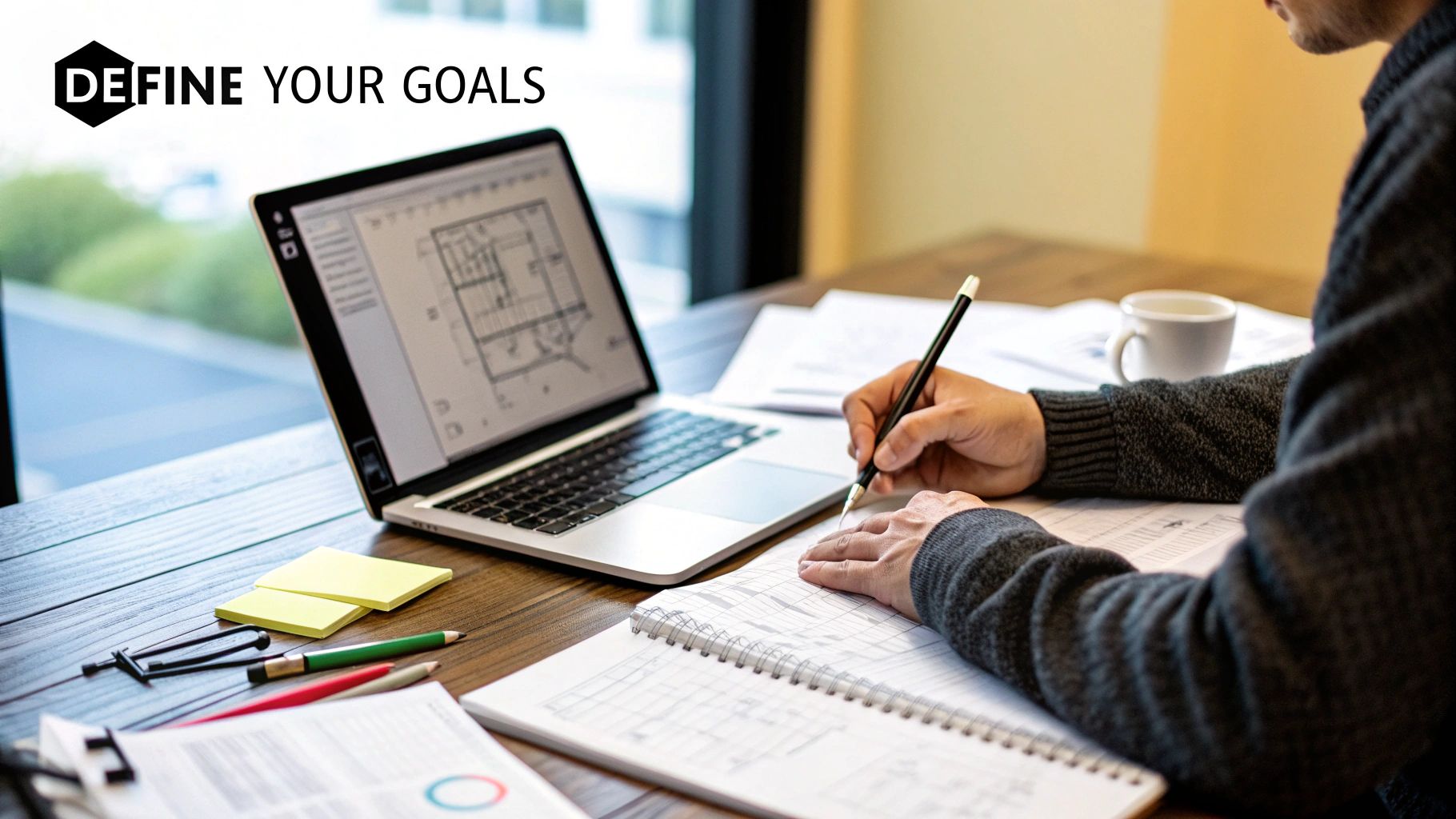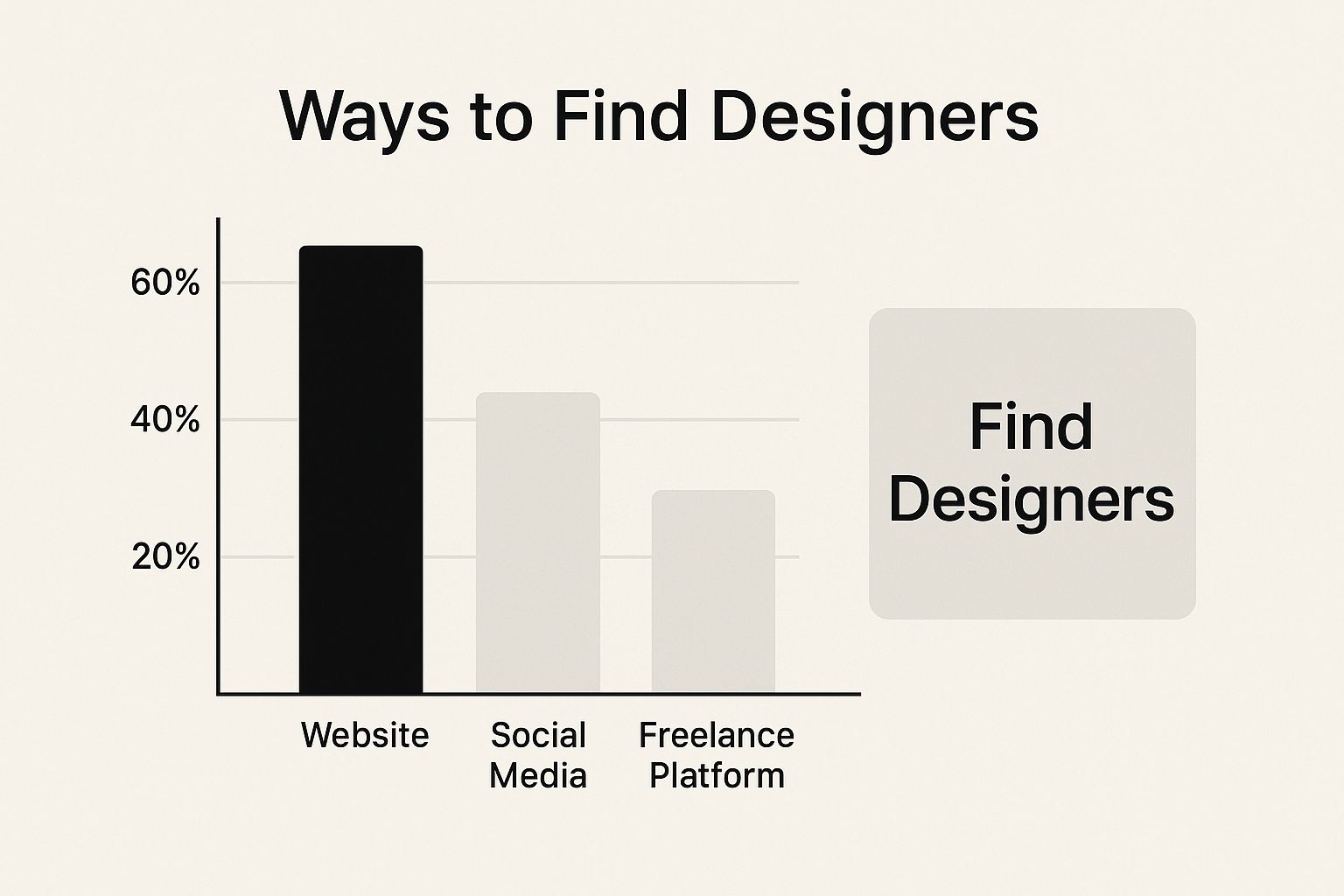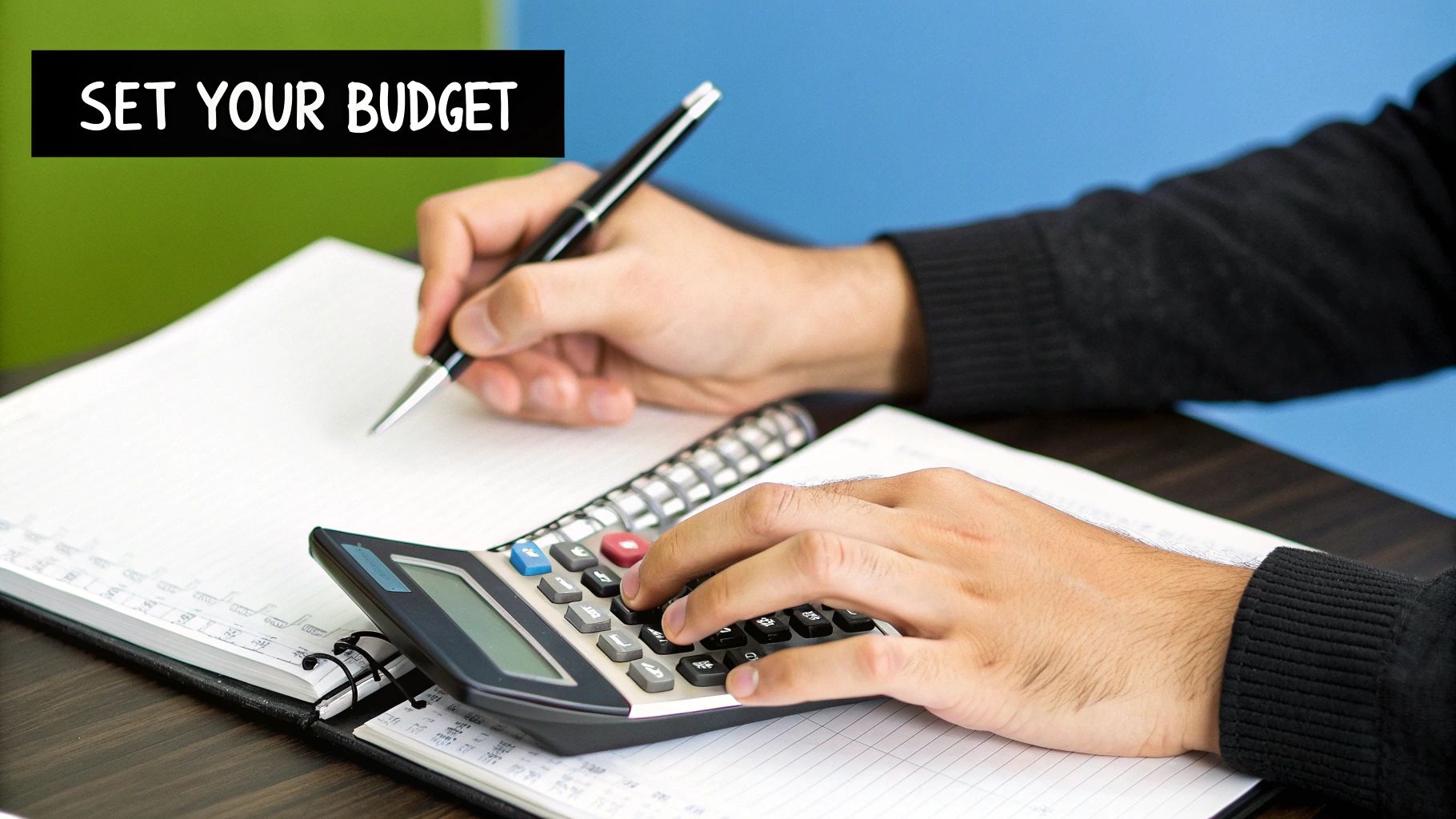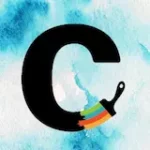Before you even start looking for a graphic designer, you need to do some prep work. It's a simple truth, but one that gets overlooked all the time. The best way to find top-tier talent—whether on specialized freelance sites, professional networks like Dribbble, or through an agency—is to know exactly what you need before you reach out.
A fuzzy idea is the fastest way to get a fuzzy result.
Laying the Groundwork for Your Designer Search

Before browsing a single portfolio or posting a job, you’ve got to look inward. I’ve seen it happen countless times: a project goes off the rails not because the designer was bad, but because the initial direction was a mess.
A request like "I need a new logo" is a recipe for disaster. It guarantees endless back-and-forth, wasted hours, and frustration on both sides. To attract real pros who deliver, you need to build a solid foundation first. That means getting crystal clear on your goals, your brand, and a realistic budget. It’s the single most important thing you can do.
Interestingly, this isn't unique to hiring creatives. You'll see the same core ideas in most strategies for hiring technical talent—clarity is king.
Craft a Compelling Creative Brief
Think of your creative brief as your project’s North Star. This is the document that lays out everything a designer needs to know to nail your vision. A great brief acts like a filter, pulling in the right designers and politely showing the wrong ones the door.
Make sure your brief clearly explains:
- Project Goals: What problem are you actually solving? Are you trying to boost brand awareness, drive sales through a new campaign, or get a product launch-ready?
- Target Audience: Who are you talking to? Get specific about their demographics, what keeps them up at night, and what they love.
- Specific Deliverables: List out exactly what you need. A set of social media graphics? A full brand style guide? Packaging for a new product line? Be precise with formats and dimensions.
- Timeline: Put a realistic schedule on paper, complete with key milestones and a final deadline. This shows you're a pro who respects their time and process.
A detailed brief doesn't just guide the designer—it forces you to solidify your own strategy. It’s the difference between wandering aimlessly and following a map to a specific destination.
Set an Effective Budget
"What's your budget?" That question can feel awkward, but dodging it just leads to a massive waste of time for everyone. The graphic design industry is huge and getting bigger—we're talking a global market valued at around $43.4 billion. The U.S. slice alone is projected to hit $11.3 billion by 2025.
What that means for you is that skilled designers are in high demand. A fair budget is non-negotiable if you want to attract the good ones.
To figure out what's fair, you need to understand the different ways designers charge:
- Hourly: Great for ongoing work or projects where the scope might change.
- Per-Project: The go-to for a single, well-defined task like a logo or a website homepage design.
- Retainer: You pay a monthly fee for a set amount of work. This is perfect if you need consistent design support month after month.
Do a little homework on what a project like yours typically costs. Being prepared with a competitive and realistic budget shows you’re serious and ready to build a great partnership from day one.
Where to Discover Top Creative Talent
Okay, you’ve got your brief and budget dialed in. Now for the fun part: finding your creative partner. The modern hunt for a great graphic designer isn't about looking under one rock; it’s about knowing which channels the best talent calls home. From bustling freelance hubs to visual playgrounds, knowing where to look is half the battle.
The way businesses and creatives connect has completely changed. By 2025, it's expected that freelancers will make up about half of the entire graphic design workforce—a huge shift driven by online platforms. And with the industry’s revenue on track to hit nearly $57.8 billion by 2026, the demand for skilled designers is only getting hotter.
So, where do you start?
Freelance Marketplaces for Every Scale
For many, freelance marketplaces are the first stop. They’re packed with talent and have built-in tools for things like messaging and payments, but they aren't all created equal. Each one serves a slightly different purpose.
- Upwork: This is the jack-of-all-trades. It’s solid for both small, one-off jobs and bigger, ongoing projects. You can post a job and let proposals roll in, or you can take the driver's seat and search for freelancers yourself.
- Fiverr: Don’t let the name fool you. While it started with quick $5 gigs, Fiverr has seriously leveled up. Their "Fiverr Pro" section features vetted, top-tier freelancers who are perfect for more substantial projects.
- Toptal: If you need the best of the best and have the budget for it, Toptal is your platform. They're incredibly selective, accepting only the top 3% of applicants. It’s the go-to when your project is critical and you can’t afford to take chances.
For a complete playbook on the entire hiring journey, our full guide on how to hire designers lays out the whole process.
To help you choose the right starting point, here’s a quick comparison of the different kinds of platforms available.
Comparing Platforms for Finding Graphic Designers
| Platform Type | Best For | Pros | Cons |
|---|---|---|---|
| Freelance Marketplaces | Quick hires, defined projects, varied budgets. | Huge talent pool, built-in project management and payment tools, competitive pricing. | Can be overwhelming, quality varies widely, may require more vetting. |
| Portfolio Communities | Finding a specific aesthetic, visual-first hiring. | Direct access to high-quality work, easier to judge style and quality upfront, great for proactive outreach. | No built-in project tools, requires more manual outreach, designers may not be actively looking for work. |
| Personal & Pro Networks | High-trust referrals, finding vetted talent. | Candidates are pre-vetted by your network, higher chance of a good fit, builds on existing relationships. | Limited pool of candidates, can be slow, dependent on the strength of your network. |
| Specialized Agencies | Complex projects, full-service needs, strategic guidance. | Team-based approach, high level of expertise, comprehensive project management. | Higher cost, less direct control over the individual creative, longer onboarding process. |
Ultimately, the "best" platform really depends on your specific needs, budget, and how much time you're willing to invest in the search.
Portfolio-Driven Communities
If you’d rather lead with your eyes, portfolio sites are where it’s at. Think of them as digital galleries where designers put their best foot forward.
Platforms like Dribbble and Behance are goldmines. You can browse for designers based on their specialty, style, or even location. Instead of wading through a sea of proposals, you get to proactively find creatives whose vibe already clicks with your brand.
Here's a look at Dribbble’s homepage. You can immediately dive in and start exploring curated work from designers all over the world.

This visual-first method lets you quickly gauge a designer’s quality before you even send that first message.
Pro Tip: Don’t just stop at the pretty pictures. Click into a designer’s projects and look for case studies or process notes. This gives you a peek behind the curtain into how they think and solve problems, not just what they can produce at the finish line.
Tapping Into Your Network and Specialized Experts
Sometimes the best person for the job isn't scrolling through a public job board. Never underestimate the power of your own network. A quick post on LinkedIn or a simple ask to a trusted colleague for a recommendation can often unearth some incredible, under-the-radar talent.
And what if your needs are bigger than a single freelancer? For a major project like a full website overhaul, you might want to bring in the heavy hitters. Exploring how to find and vet trusted expert website design consultants can be a game-changer, as they bring a whole team's worth of strategic thinking to the table.
No matter which path you choose, the goal is the same: find someone whose work you love and who you can build a great working relationship with.
Alright, you've sifted through the platforms and have a shortlist of designers who look promising. This is where the real work begins. A killer portfolio is one thing, but it’s really just the cover of the book. To find a graphic designer who will be a true partner for your business, you have to dig a lot deeper than just pretty pictures.
Your mission here is to size them up in three key areas: technical chops, creative problem-solving, and professional fit. I’ve seen it a hundred times—a designer has an incredible aesthetic, but if their work doesn't actually solve a business problem, or if they're a nightmare to work with, the project is doomed from the start.
Looking Beyond the Final Polish
A portfolio isn't just a gallery of greatest hits; it's a collection of solved problems. Don't just breeze through the visuals. Click into the individual projects and hunt for the story—the case study. A truly great designer doesn't just show you the slick final product; they walk you through the why behind their choices.
As you look through their work, see if you can find the answers to these questions:
- What was the original challenge? A designer who can clearly state the business goal shows they're thinking strategically, not just artistically.
- Who was this for? This proves they design with a real audience in mind, not just for their own creative satisfaction.
- What did their process look like? Did they show sketches, wireframes, or different concepts they explored? This is your window into how they think and iterate.
- Did it actually work? The best designers often back up their work with results, like client testimonials or even metrics that show their design made a real impact.
A portfolio that only shows polished final designs is like a movie that skips straight to the credits. The real story—and the designer's true talent—is in the messy middle, the process, and the challenges they had to wrestle with.
Conducting an Insightful Interview
Once a portfolio passes the sniff test, it's time to talk to a real human. This conversation is far from a formality. It’s your best shot at gauging their communication style, how they handle feedback, and if they're reliable. Sure, you'll talk about rates and timelines, but the most valuable takeaways will come from asking the right questions.
Get past the generic stuff. You need to understand how they navigate the bumps and pivots that are inevitable in any creative project. What happens when a client gives them tough feedback? How do they handle it when a project's scope suddenly changes?
For a full playbook on what to ask, checking out some well-thought-out interview questions for creatives will give you a solid foundation for these make-or-break conversations.
Key Questions to Ask Potential Designers
To really vet a candidate, your questions need to get at their workflow and collaborative spirit. Here are a few of my go-to questions to get you started:
- "Walk me through a project you're really proud of. What was the biggest curveball, and how did you knock it out of the park?" This question gets right to their problem-solving skills and resilience.
- "How do you like to get feedback? Tell me about a time you got some difficult notes from a client and how you handled it." This is absolutely critical for checking their ego at the door and seeing if they can truly collaborate.
- "What's your typical process for a project like this one, from the initial kickoff call to handing over the final files?" This helps you map out their workflow and sets crystal-clear expectations for everyone involved.
By pairing a deep dive into their portfolio with a few smart interview questions, you can move forward feeling confident that you've found a designer with both the skills and the professional attitude to really bring your vision to life.
Choosing the Right Hiring Model for Your Needs
How you bring a designer on board directly impacts your budget, your workflow, and ultimately, the creative that comes out of it. Finding the right person is one thing; figuring out the best way to work with them is a whole other ball game.
Let's break down the most common ways to hire a creative so you can find the perfect fit for your business.
This isn't just a minor decision. The demand for great design is huge, and the industry reflects that. In the U.S. alone, the Bureau of Labor Statistics clocked around 265,000 graphic design jobs back in 2021. But here’s the fascinating part: something like 90% of designers are freelancers. That tells you there's a massive pool of independent talent out there, ready to jump on your project.
The Freelance Model for Ultimate Flexibility
Hiring a freelance graphic designer is easily the most popular route, especially if you have specific, project-based work. Need a killer new logo, a fresh set of social media templates, or a one-off brochure for a trade show? A freelancer is almost always your best bet.
This model gives you incredible agility. You can bring in a specialist for a single project without the long-term commitment and overhead of a full-time employee. It’s a nimble approach that lets you tap into a global talent pool and find someone with the exact niche skills your project demands.
For instance, a startup scrambling to get a pitch deck ready for an investor meeting can hire a presentation design guru for just a week. Once the project's done, the contract ends. Clean and simple.
The secret to making it work with freelancers? Crystal-clear communication. A well-defined project scope isn't just a nice-to-have; it's non-negotiable. Without it, you're inviting scope creep and budget blowouts, turning a flexible gig into a frustrating mess.
The In-House Designer for Deep Brand Immersion
When your design needs are constant and core to your business, bringing a designer in-house is a total game-changer. This is the move for companies that are always churning out marketing materials, need ongoing website updates, and want a creative who lives and breathes the brand day in and day out.
An in-house designer gets woven into the fabric of your company culture. They'll understand your mission, your audience, and your long-term vision on a level an outsider just can't match. Over time, this deep immersion leads to incredibly cohesive and strategic brand visuals.
Sure, the upfront cost is higher, but the long-term payoff is a unified brand voice and having creative support on speed dial.
The Agency Partnership for All-in-One Firepower
But what if you need more than just one person? What if you need a whole creative army? That's where partnering with a design agency comes in. You get access to an entire team—strategists, designers, copywriters, and project managers—all under one roof.
This model is perfect for huge, complex undertakings like a complete brand overhaul, a major product launch, or a massive marketing campaign. Agencies offer a structured, end-to-end service, handling everything from the initial strategy to the final deliverables. You get a whole buffet of skills without having to hire each specialist yourself.
It's the priciest option, no doubt, but for mission-critical projects, it delivers unparalleled creative horsepower and strategic oversight. And just like with freelancers, starting on the right foot is key—check out our guide on building a solid creative project brief template to make sure you kick things off right.
Onboarding Your New Designer for Immediate Impact

You’ve signed the contract and shaken hands—congrats. But now the real work begins. Those first few days with a new designer are absolutely critical for setting the tone of your entire relationship. A chaotic, disorganized start breeds confusion, while a thoughtful onboarding process empowers your designer to start creating great work, fast.
This is so much more than just sending a welcome email. It's about strategically aligning on expectations, handing over the right tools, and building a collaborative vibe from day one. I’ve seen it time and time again: a little investment upfront prevents a ton of misunderstandings and costly revisions down the line. It really paves the way for a productive, long-term partnership. A lot of these principles are actually part of the bigger picture of how to hire a graphic designer in the first place.
Set the Stage for Success
Before your designer even logs on for their first day, get a digital welcome kit ready. This isn’t a fruit basket; it’s a one-stop-shop for everything they’ll need. Think of it as handing them the keys to your brand's kingdom.
This kit should give them immediate access to:
- Brand Assets: A shared folder with every version of your logo, your official brand color codes (HEX, RGB, CMYK), and the actual font files.
- Style Guides: Any existing brand guidelines that lay out the rules for voice, tone, and visual identity. This is their playbook for keeping things consistent.
- Project Management Tools: Invitations to your team’s Slack, Asana, Trello, or whatever platform you use to talk and track work.
Your goal here is to eliminate friction. A designer spending their first day hunting down a logo file is a designer who isn't designing. A well-organized welcome kit shows you respect their time and sets a professional standard right out of the gate.
Conduct an Effective Kickoff Meeting
That first call is more than a quick "hello." It's a mission briefing. This is your chance to solidify the project goals and, just as importantly, establish how you'll communicate.
Make sure you nail these key areas during the meeting.
Clarify Project Goals and Milestones
Pull up the creative brief again and walk through the main objectives. Then, break the project down into smaller, bite-sized milestones with firm deadlines. This creates a shared roadmap everyone can see.
For a website redesign, for instance, your milestones might look like this:
- Wireframe approval by this Friday.
- Homepage mockup delivered next Wednesday.
- Internal page templates completed in 2 weeks.
Define the Feedback Loop
Decide exactly how and when feedback is going to happen. Will you leave comments directly in Figma? Will you gather all your team's notes into one email each week? Agreeing on a clear process from the start prevents that dreaded flurry of scattered, contradictory feedback. It makes the entire workflow smoother for everyone.
Frequently Asked Questions About Hiring Designers
Even with a solid plan, a few questions always seem to pop up during the hiring process. That's totally normal. Getting these sorted out ahead of time means you can move forward with confidence and find a designer who’s a genuinely great fit for your business.
Let’s tackle some of the most common ones we hear.
How Much Does It Cost to Hire a Graphic Designer?
Ah, the big one. The honest, no-fluff answer is: it varies—a lot. What you pay depends on the designer's experience, where they're based, and how you hire them. Remember, you’re not just paying for someone's time; you're investing in their expertise, creativity, and problem-solving skills.
- Hourly Rates: A junior freelance designer just starting out might be around $25 per hour. On the other end, a highly seasoned expert or a specialist with a unique skill set could easily command $150 per hour or more.
- Project-Based Fees: For a specific task, like a one-off logo design, you could see prices from a few hundred dollars for a basic concept to several thousand for a full-blown branding package.
- Agency Retainers: This is usually the largest investment. Think of it as having a design team on call. These often start at a few thousand dollars per month for ongoing, dedicated support.
Think of design pricing like real estate: location (in this case, experience and demand) heavily influences the cost. A clear budget helps you filter for designers in your price range from the start.
What Is the Difference Between a Graphic Designer and a UX Designer?
It’s really easy to mix these two up, but they focus on completely different parts of a customer's experience. Nailing this distinction is key to hiring the right person for the job.
A graphic designer is fundamentally a visual communicator. They’re obsessed with creating aesthetics that build a brand’s personality and get its message across clearly. We're talking logos, marketing materials, illustrations, and social media graphics. Their main goal? Make the brand look amazing and communicate effectively.
A UX (User Experience) designer, however, is a problem-solver who zeroes in on the feel and function of a product, like an app or a website. They map out user journeys, do the research, and design interfaces to make sure the whole experience is intuitive and even enjoyable. Their main goal is to make the product work seamlessly for the person using it.
Should I Ask for a Test Project Before Hiring?
Asking for a test project—often called "spec work"—is a tricky subject in the design world. While it might feel like a safe way to vet someone's skills, it can be a major red flag for top-tier talent.
Honestly, most experienced designers will politely decline unpaid test work. Why? Because their portfolio is their test. It's a carefully curated gallery of real-world projects that already prove their process, style, and ability to solve problems.
If you feel you absolutely have to see how they'd tackle a specific task, the best way to handle it is to offer a small, paid micro-project. This approach shows you respect the designer's time and expertise, turning what could be an awkward ask into a professional, fair trial run. This kind of small-scale collaboration gives you priceless insight into their working style before you commit to something bigger. For more tips on defining your visual needs, our guide on how to build a strong brand identity is a great place to start.
At Creativize, we take the headache out of finding the perfect creative partner for your business. Our platform connects you with vetted, local talent, making it easier than ever to discover and hire the right designer for your project. Explore portfolios and start building your creative team today at https://creativize.net.

